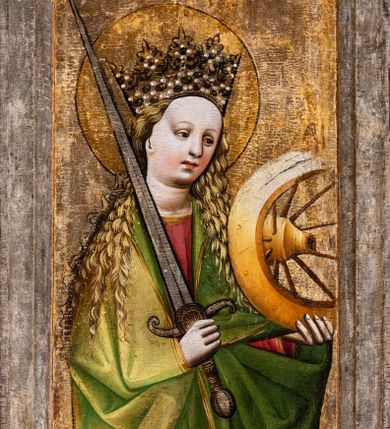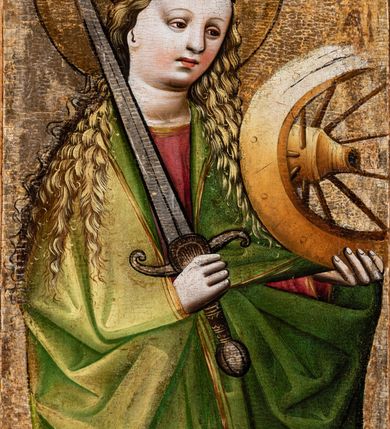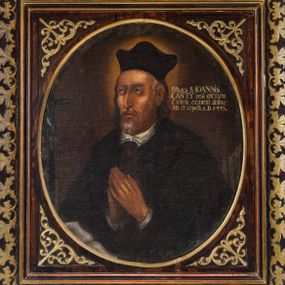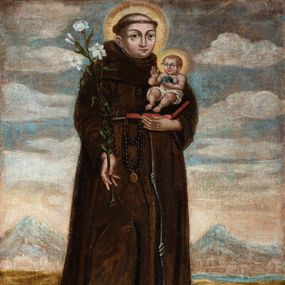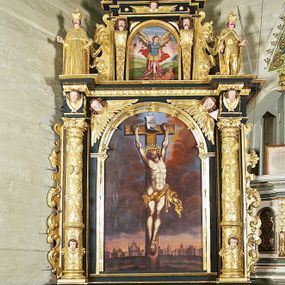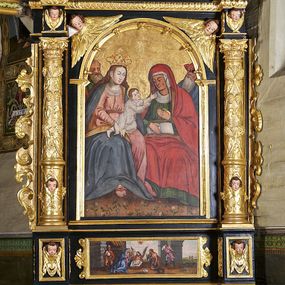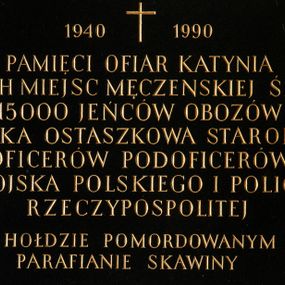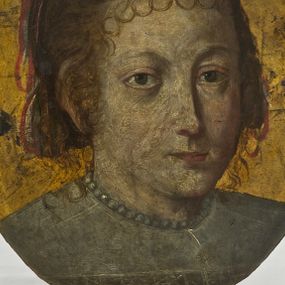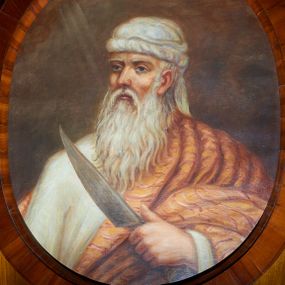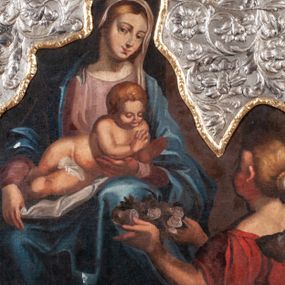
A front left wing of the old triptych of Our Lady of the Immaculate Conception
Identifier
DZIELO/05111
Category
Picture
Amount
1
Catalogue note author
Justyna Kuska
Abstract
The painting of Our Lady of the Immaculate Conception was created in the years 1460-1470 in the workshop of an unknown master operating in Cracow, who is also credited with an authorship of a triptych from the parish church in Zator. Originally, the painting was part of a gothic triptych, which also included paintings, depicted on the sides of the high altar, with representations of Saint Catherine and Saint Barbara (on the obverses) and Gabriel the Archangel and the Mother of God (on the reverses), forming together the Annunciation group. The triptych had been probably intended for the church in Paczółtowice from the beginning, but it did not serve as the high altar. The identity of the funder of the altar is not confirmed by sources, however, researchers point to Jan Paczółtowski of the Topór coat of arms, recorded by Jan Długosz in the years 1470-1480. After the construction of the present temple in Paczółtowice at the beginning of the 16th century, the triptych was transferred there. It was probably dismantled at the beginning of the 17th century, during the construction of a new high altar from the foundation of Stanisław Tarnowski, the coat of arms of Rola, and his wife – Elżbieta née Czerska. The triptych of Our Lady of the Immaculate Conception was probably typical of the 15th century – devoid of predella and altar finial, with a reredos with the central image of Our Lady of the Immaculate Conception and a pair of moving wings, depicting the holy martyrs: Catherine of Alexandria and Barbara (on the obverses) as well as Gabriel the Archangel (on the reverses), forming together the Annunciation group. On weekdays it remained closed, showing the faithful a visible scene of the Annunciation to Mary. The solemn side with a representation of the Virgin Mary with the Child, assisted by holy virgins, appeared to the faithful on Sundays and during church holidays. The Annunciation on the reverses of the wings of the triptych in Paczółtowice adopts iconographic formula typical of the panel painting of Lesser Poland, i.e. with kneeling Gabriel the Archangel (depicted on the left wing) and Mary (depicted on the right wing) dressed in white robes, referring to her virginity, who at the sight of an angel interrupts reading the book, holding in her hand. It is a popular theme in the panel painting of Lesser Poland. It was repeated on numerous reredoses in the years 1420-1480, always on the reverse side of wings (including reredoses in Łopuszna, Przydonica, Racławice Olkuskie and Sromowce Wyżne). The depiction of the Virgin Mary and the Child, visible during the ceremonial opening of the triptych, is a cult representation. Mary depicted in the painting in Paczółtowice received the attributes proper to the representation of the Woman of the Apocalypse, taken from the text of Saint John's Book of Revelation: a radiant aureole surrounding the figure and a crescent moon underfoot. The depiction of Mary surrounded by a flaming aureole, already in the Middle Ages, began to be associated with the immaculate conception of Mary, although this idea gained the power of dogma only in 1854. The burning bush, but not consumed by flames, visible behind Mary, symbolises in this case her chastity and virgin motherhood. The ideological content of the painting is complemented by the depictions of angels holding banderoles with the text of the Marian antiphons popular in the 15th century: "Rejoice, Queen of Heaven" visible in the upper corners, as well as Mary's rich robes indicating her royal role. Saint Catherine of Alexandria and Barbara depicted on the obverses of the triptych wings accompanied Mary on the solemn side of the open altar, forming with her a group called the Sacred conversation (Sacra conversazione). Both holy virgins, who died a martyr's death in the first centuries of Christianity and were depicted on the wings of the triptych in Paczółtowice, were exceptionally worshipped in medieval Lesser Poland. Their presence in the company of Our Lady of the Immaculate Conception can also be interpreted as a reference to Mary's chastity. In terms of style, this triptych is considered by researchers to be the "late phase of Cracovian painting during the so-called idealising period" in the third quarter of the 15th century. In 1682, under the will of Adam Negowicz, a silver robe, a crown, rays and the moon under Mary's feet were added to the painting. This robe was replaced in 1800 with the current silver-plated one, made of copper. It was made by Jerzy Kaltner of Cracow. The painting was renovated several times: in 1943 by the painter Józef Ryłka; in 1957, on the recommendation of the Provincial Conservator of Monuments in Cracow – side wings of the former triptych were maintained; in 1995 by prof. Małgorzata Schuster-Gawłowska of the Academy of Fine Arts in Cracow, who performed comprehensive renovation works.
Other works from this place
Other works from this year

Picture
Picture

Picture
Front right wing of the old triptych of Our Lady of the Immaculate Conception

St. Margaret's Church

Picture
Our Lady of the Immaculate Conception

Picture
Reverse side of right wing of the old triptych of Our Lady of the Immaculate Conception

Picture
Triptych with paintings of the Madonna with the Child and St. Catherine and St Barbara (obverse), St. Nicholas and St. Stanislaus (reverse)
Similar works
How to cite?
Justyna Kuska, "A front left wing of the old triptych of Our Lady of the Immaculate Conception", [in:] "The Sacred Lesser Poland Heritage", 2025, source: https://sdm.upjp2.edu.pl/en/works/a-front-left-wing-of-the-old-triptych-of-our-lady-of-the-immaculate-conception
